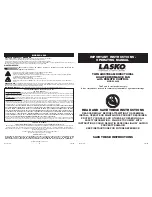
The contact opening gap must
be no less than 3 mm.
• Specifications for the power supply must correspond
to the electrical data on data plate A (Fig.A)
Typical application
Fig. 3;
Reduced thickness, made possible due to the use of
ventilators powered by external rotor motors, means
that the device can even be fitted in low spaces.
Alternatively, they are also suitable for ceiling or wall
mounting, using brackets supplied.
N.B.
The appliance’s outlet port must always be connected
to a suitable duct.
Installation
Fig. 1÷4;
N.B.
If the appliance is installed without a duct attached to
its inlet port (i.e. with an open air intake) and at a
height below 2.3 metres,a protective grille must be
fitted over the inlet port (fig.1).
Use
The device features constant operation, at one of 3
available speeds set during installation.
Alternatively, the device can be connected to an exter-
nal electronic regulator (not supplied), which enables
the device to be turned on/off, and the selection of
speed from 3 available options, or continuous speed
regulation through a potentiometer.
Electrical Connections
Fig. 5÷7
Maintenance / Cleaning
Fig. 8÷9
Important
information
concerning the environmentally
compatible disposal
IN CERTAIN EUROPEAN UNION COUNTRIES THIS
PRODUCT DOES NOT FALL WITHIN THE
REQUIREMENTS OF THE NATIONAL LAWS
IMPLEMENTING DIRECTIVE WEEE, AND IN
THESE COUNTRIES THE PRODUCT IS NOT
SUBJECT TO SEPARATE DISPOSAL OPERATIONS
AT THE END OF ITS WORKING LIFE.
This product conforms to EU Directive2002/96/EC.
This appliance bears the symbol
of the barred waste bin. This
indicates that, at the end of its
useful life, it must not be disposed
of as domestic waste, but must be
taken to a collection centre for
waste electrical and electronic
equipment, or returned to a
retailer
on
purchase
of
a
replacement.
It is the user's responsibility to dispose of this
appliance through the appropriate channels at the end
of its useful life. Failure to do so may incur the
penalties established by laws governing waste
disposal.
Proper differential collection, and the subsequent
recycling, processing and environmentally compatible
disposal of waste equipment avoids unnecessary
damage to the environment and possible related
healthrisks, and also promotes recycling of the
materials used in the appliance.
For further information on waste collection and
disposal, contact your local waste disposal service, or
the shop from which you purchased the appliance.
Manufacturers and importers fulfil their responsibilities
for recycling, processing and environmentally
compatible disposal either directly or by participating
in collective systems.
7
ENGLISH





































